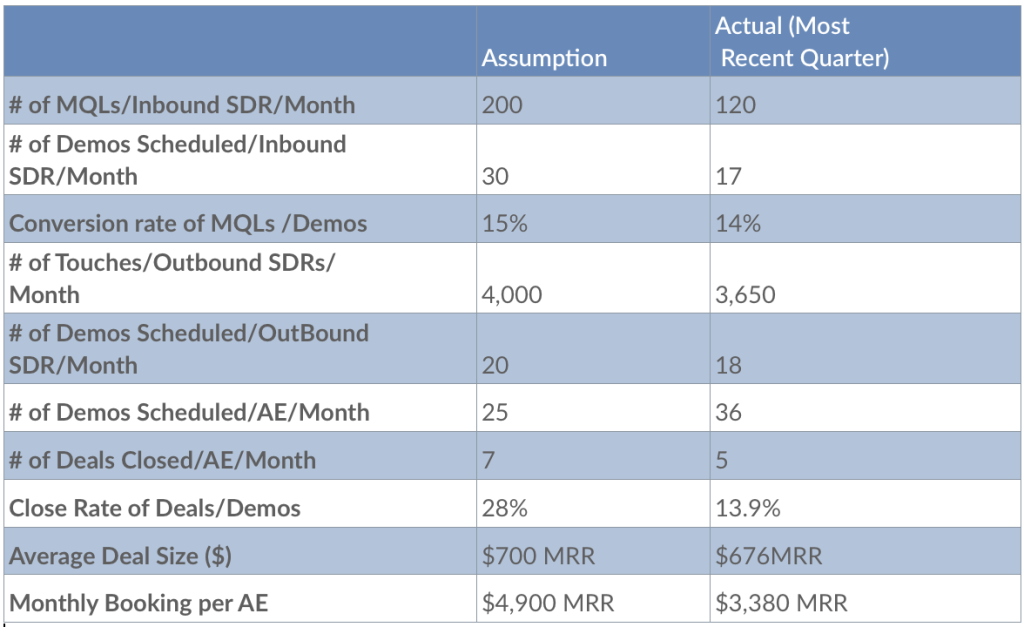A software startup in Silicon Valley is tracking to beat $3 million in revenues in its first full year of operation. It is time to come up with a sales plan for next year. The board had been encouraging the CEO to ‘“step on the gas” and aim for $9 million next year.
The CEO, CFO, and VP of Sales gather around the polished glass table in the newly redecorated conference room to finalize the business plan for the next year. The CEO gets the ball rolling, “So is everyone comfortable with this plan to reach $9 million next year?” The VP of Sales says he’s onboard, but that tripling sales will also mean tripling the sales team. The CFO chimes in saying that means 16 new hires in sales — another ten account execs and six more SDRs — and 14 new hires in other departments to support the growth.
The board approves the aggressive growth and sales plan and the required spending. They congratulate themselves that now they can raise an up round to support the growth, and the hiring spree begins.
The first quarter results are a near miss, but the company manages to close its round of funding based on the growth plan. The second quarter results diverge even more from the sales plan. When the third quarter results show annual sales growth is “only” 90% to date, the VP of Sales is called on the carpet to explain, and all he can offer is that it’s taking more time than expected for the sales team to hit their stride. What went wrong?
B2B giant salesforce.com has made growth look easy, mushrooming into a $7 billion company in just 15 years since it was launched. But planning for growth is never that easy, especially for B2B tech startups. The above scenario is actually quite common in Silicon Valley, as new firms are often pushed to grow faster than they should. According to the Startup Genome Report 92% of Startups fail and 74% of those failed due to premature scaling, ie hiring and spending money on sales and marketing before they are ready to. Mark Leslie and Charles Holloway break down the whys and wherefores of the “Organization sales learning curve” in their seminal 2006 article in HBR.
Sales Plan: The Sales Learning Curve
When you dig into cases where sales growth does not even come close to expectations, you often discover the real problem is that the sales team was not performing at capacity before the ramp up. One common situation is that you meet sales goals your first year because two of your five sales reps are crushing their quota, but your other three reps are underperforming. Then in year two, your two superstar reps also start to underperform. Why? Because the CEO had been feeding them prime leads and deals, and the easy deals are all gone now.
If your sales team is not really performing, then adding five new AEs will not result in doubling sales bookings, but more likely in eight or nine reps not making their quota. You must be certain you can actually derive value from a larger team before adding sales capacity.
The recent boom and bust of managed benefits startup Zenefits is an instructive case in point. After a very strong year in 2014, Zenefits CEO Parker Conrad promised investors 1000% growth in 2015, raised $583 million and commenced a gigantic hiring spree. Unfortunately, the ramp up at Zenefits did not produce the promised results, with the company “only” managing 300% growth in 2015 and Conrad losing his job (although some have argued that he lost his job due to compliance issues).
Analyze Your Sales Capacity Utilization before Hiring
If you are going to avoid a situation like Zenefits, you need to get a firm grip on your actual sales capacity, that is, the efficiency and effectiveness of your sales team.
All too often planning for sales teams just involves taking the assumed average quota by rep and multiplying that figure by a given number of reps to match the current financial plan. The thinking goes “if we got $3 million in sales bookings last year with an eight-people sales team, just double up to 16 and we will hit our $6 million goal.”
The problem with this kind of generic sales plan for growth is that if your actual metrics are below your assumptions for more than 25% of your reps, you still have a lot of unused capacity, and bringing in more reps will not result in increased sales. In this case, instead of increasing headcount, you need to work on improving the efficiency of your sales process.
The table below offers an example of sales model metrics for a growing SaaS startup.
The above metrics show that the sales team is operating below capacity. To increase sales bookings and achieve better sales capacity usage, you need to consider:
– If your inbound SDRs are not consistently receiving 200 marketing qualified leads a month, you need to work with marketing on increasing the number of leads generated before adding additional inbound SDRs
– If the close rate of your AEs is less than 20%, then you are better off investing in coaching or training your reps to improve their effectiveness than hiring more AEs.
– If your outbound SDRs are not performing 200 touches a day, then ponying up for a sales acceleration tool or Power Dialer to consistently increase their activity levels is clearly a worthwhile investment.
Before ramping up your team, you also need to ensure that your sales model metrics are not skewed by one or two “superstar” reps who are masking poor performances by other reps.
The overall efficiency and effectiveness of your team will inevitably slip when you onboard new reps. That’s why the whole idea that you just expand your team and sales metrics will improve is flawed. You may have to do both: increase your sales capacity and improve the utilization of that increased capacity. But with that comes increased risk.
According to entrepreneur and tech venture capitalist Jason Lemkin, the best way to gauge the health of your startup is to monitor the production of qualified leads. Lemkin introduces the concept of “Lead Velocity Rate”, that is, your growth in qualified leads measured month over month. This argues that you shouldn’t increase the size of your sales team until you achieve aa Lead Velocity Rate that can support a larger team.
Growth is a Journey of increasing demand and capacity. Too many B2B Tech companies, especially venture back ones, make the mistake of increasing capacity without paying enough attention to improving the utilization and demand of their capacity. More often than not this does not translate into the expected growth in sales and meeting the sales plan.
Mansour Salame
Latest posts by Mansour Salame (see all)
- The Failed Sales Plan - May 20, 2016
- What Percentage of Leads Should You Close? - April 14, 2015
- Anatomy of an Inside Sales Team: The 5 Key Parts - February 25, 2015




Excellent analysis- managing performance successfully requires this level of understanding to ensure your AE’s are performing at expected levels before the team is scaled. Understanding the market’s size, the competition, the sales cycle and sharing performance daily to keep everyone focused helps leadership see opportunities and potential problems with the current team before you begin expansion. More isn’t better, better is better.
Very nice piece . Market optimism is one thing. Letting intoxicated egos make sweeping decisions based on assumptions that have been duct-taped onto other assumptions is another.